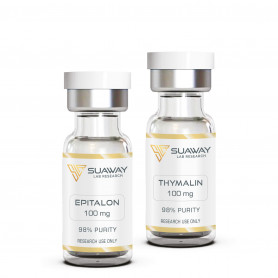SEMAGLUTIDE - 5mg
Semaglutide is a modified form of the naturally present GLP-1 peptide, which is recognized for its ability to regulate blood sugar and boost insulin release. Studies indicate that Semaglutide could also have positive effects on cardiac, hepatic, and pulmonary health, as well as potentially mitigating the impact of Alzheimer's disease. Additionally, it has been found to effectively curb hunger by slowing down the emptying of the stomach and limiting the movement of the intestines. As a GLP-1 analog, it is designed to both enhance insulin production and inhibit the release of glucagon in a manner dependent on glucose levels. Semaglutide has demonstrated the largest weight loss of any obesity medication to date with reductions of approximately 15% of initial weight at 68 weeks.
Description
STRUCTURE
Sequence: HXEGTFTSDVSSYLEGQAAK-OH.steric diacid-EFIAWLVRGRG
Molecular Formula: C187H291N45O59
Molecular Weight: 4113.64 g/mol
CAS Number: 910463-68-2
Peptide purity: greater than 98%
Other details: No TFA Salt
Storage: Lyophilized peptide must be stored at -20°C and peptide solution at +4°C.
Semaglutide has low oral and excellent subcutaneous bioavailability.
DESCRIPTION
GLP-1, an abbreviation for glucagon-like peptide-1, is a concise peptide hormone naturally found in the body, consisting of 30-31 amino acids. Its main role is to regulate blood sugar by amplifying insulin release. Furthermore, it aids in safeguarding the insulin reserves of beta cells by fostering the transcription of insulin genes. It's also associated with positive effects on the brain and central nervous system. Within the digestive tract, GLP-1 acts to curb hunger by prolonging the process of stomach emptying and minimizing the movement of the intestines. Initial studies suggest its influence extends to organs such as the heart, adipose tissues, muscles, skeletal system, liver, lungs, and kidneys.
The predominant area of GLP-1 investigation revolves around its potential in diabetes care and hunger control. Another line of research delves into its possible cardiovascular advantages. The newest, yet rapidly expanding, field of study pertains to GLP-1's potential in combating neurodegenerative conditions, especially since it's been identified to possibly hinder the formation of amyloid-beta plaques, commonly associated with Alzheimer's disease.
According to Dr. Holst, one of the most crucial roles of GLP-1 is its contribution to the "incretin effect," a metabolic hormone response that lowers blood sugar levels. In animal studies, GLP-1, along with GIP, has been identified as a key hormone in triggering this effect. Despite GIP being more abundant in circulation, GLP-1 seems to be more effective, especially when blood sugar levels are elevated.
GLP-1 receptors have been found on pancreatic beta cells, confirming that GLP-1 directly influences insulin release from the pancreas. When used alongside sulfonylurea medications, GLP-1 has been observed to enhance insulin secretion to the point of causing mild low blood sugar in a significant portion of test subjects. Elevated insulin secretion also leads to various beneficial effects, such as increased protein synthesis and amino acid uptake by muscles. Animal research suggests that GLP-1 promotes the growth and multiplication of pancreatic beta cells and may even encourage the formation of new beta cells. It has also been shown to prevent beta cell death. Overall, these findings indicate that GLP-1 could be beneficial in diabetes treatment and in shielding pancreatic beta cells from damage. In specific studies, GLP-1 has been found to protect against beta cell death induced by increased levels of inflammatory substances. Mouse models of type 1 diabetes have shown that GLP-1 can safeguard pancreatic islet cells from destruction, potentially delaying the onset of the disease.
Studies in mice indicate that GLP-1 and its related peptide can reduce the urge to eat. It seems to enhance feelings of fullness, indirectly reducing hunger. Long-term studies have shown that regular administration of GLP-1 receptor activators leads to gradual weight loss, improved cardiovascular health, and better control of blood sugar levels.
GLP-1 receptors are present throughout the heart and have been shown to improve heart function by increasing heart rate and lowering left ventricular end-diastolic pressure. This is significant as elevated levels of this pressure are linked to heart issues like cardiac remodeling and heart failure. Recent findings also suggest that GLP-1 could minimize heart attack damage by improving glucose uptake in cardiac muscle cells, independent of insulin. In canine studies, large doses of GLP-1 improved left ventricular performance and decreased systemic vascular resistance, which could alleviate the long-term effects of high blood pressure. According to Dr. Holst, GLP-1 administration post-cardiac injury has consistently shown improved heart performance in both animal models and human patients.
Emerging research suggests that GLP-1 may have a role in enhancing cognitive abilities and offering neuronal protection against conditions like Alzheimer's disease. Studies in mice have indicated that GLP-1 can improve both associative and spatial learning, even correcting learning impairments in genetically altered mice. In rat models with elevated levels of GLP-1 receptors in specific brain regions, both learning and memory performance surpassed that of regular controls.
Further studies in rodents have demonstrated that GLP-1 can guard against neuron damage caused by excitotoxicity, effectively shielding against glutamate-induced cell death. The peptide has also been observed to promote the growth of neural extensions in cell cultures.
Interestingly, both GLP-1 and its analog, exendin-4, have been found to lower the concentration of amyloid-beta and its precursor protein in neurons in mouse models. Amyloid-beta is a key component of the plaques seen in Alzheimer's disease, and while it's not definitively proven to cause the disease, it is linked to its severity. Ongoing research aims to determine if inhibiting amyloid-beta buildup could offer protection against Alzheimer's progression.
REFERENCES
A.M. Chao et al., "Semaglutide for the treatment of obesity" [PubMed]
J.P.H. Wilding et al., "Once-Weekly Semaglutide in Adults with Overweight or Obesity" [PubMed]
M. Smits et al., " Safety of Semaglutide" [PubMed]
N.C. Bergmann et al., "Semaglutide for the treatment of overweight and obesity: A review" [PubMed]
W.T. Garvey "Two-year effects of semaglutide in adults with overweight or obesity: the STEP 5 trial" [PubMed]
J. Novograd et al., "Semaglutide for Weight Loss: Was It Worth the Weight?" [PubMed]
W. Ghusn et al., "Weight Loss Outcomes Associated With Semaglutide Treatment for Patients With Overweight or Obesity" [PubMed]
A. Andersen et al., "A Pharmacological and Clinical Overview of Oral Semaglutide for the Treatment of Type 2 Diabetes" [PubMed]
G. Singh et al., "Wegovy (semaglutide): a new weight loss drug for chronic weight management" [PubMed]
DISCLAIMER
This product is intendend for lab research and development use only. These studies are performed outside of the body. This product is not medicines or drugs and has not been approved by the FDA or EMA to prevent, treat or cure any medical condition, ailment or disease. Bodily introduction of any kind into humans or animals is strictly forbidden by law. This product should only be handled by licensed, qualified professionals.
All product information provided on this website is for informational and educational purposes only.












